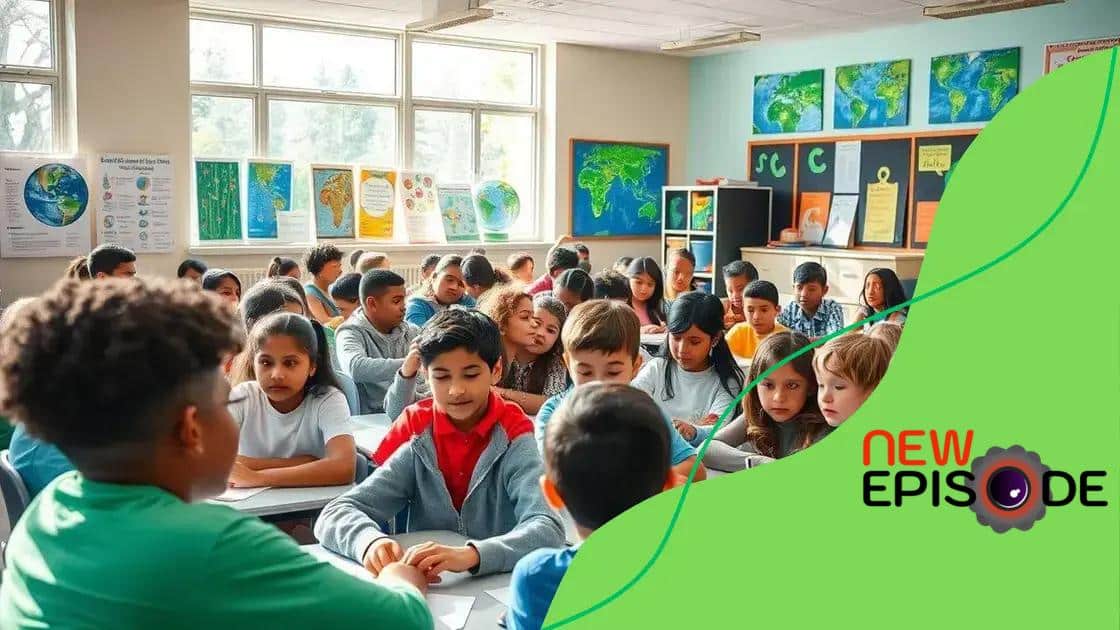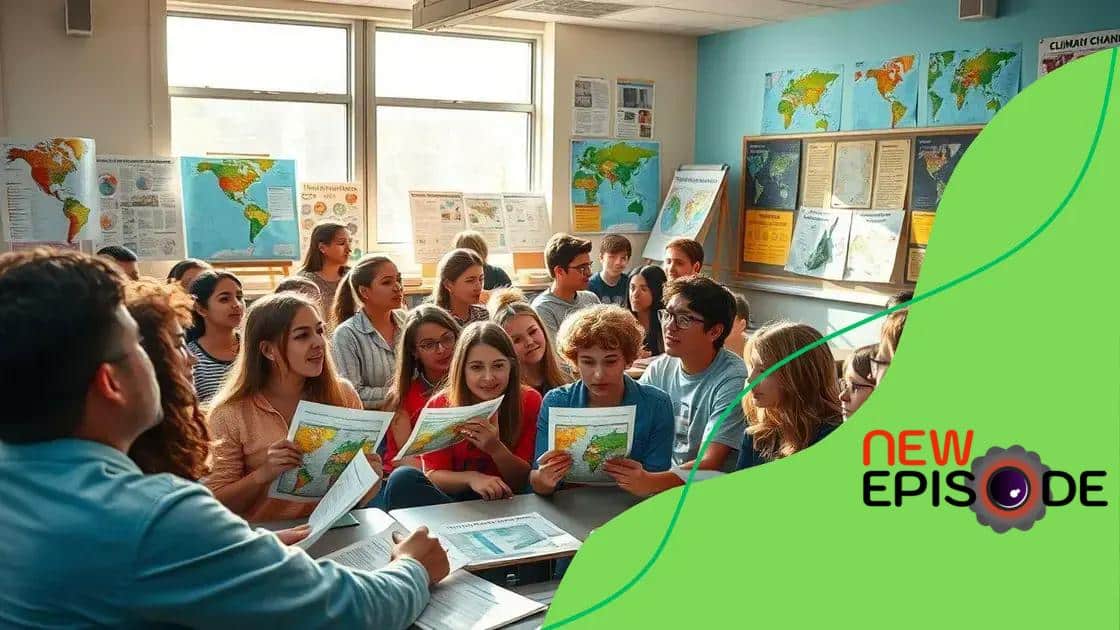Integrating climate change education into school curricula

Integrating climate change education into school curricula equips students with the necessary knowledge and skills to understand environmental issues and actively participate in sustainability efforts.
Integrating climate change education into school curricula is becoming essential as our planet faces unprecedented challenges. Have you ever considered how informed our future generations might be?
The importance of climate change education
Understanding climate change education is crucial for young minds. It lays the foundation for environmental awareness and responsibility. By integrating these lessons into school systems, we prepare students to tackle future challenges.
Benefits of Climate Change Education
Learning about climate change fosters empathy for our planet. It encourages students to think about their actions and how they impact the environment. This awareness can lead to sustainable behavior.
- Enhances critical thinking skills
- Promotes sustainability
- Encourages community involvement
- Informs future career choices
Moreover, when students engage with real-world issues, they become more connected to their surroundings. This connection helps to develop a sense of responsibility. They start feeling like active participants in making the world a better place.
Engagement through Action
Students are more likely to grasp concepts when they are part of the solutions. Schools can organize activities, such as tree planting or recycling projects. These initiatives make learning tangible and exciting.
- Organizing clean-up efforts
- Creating school gardens
- Hosting eco-friendly workshops
By engaging in such activities, students see firsthand the impact of their efforts. This hands-on approach can inspire lifelong learning about the environment. Encouraging discussions about climate change also involves them in critical conversations affecting their future.
In conclusion, climate change education not only informs but also empowers. It plays a key role in shaping responsible citizens who can lead future initiatives for a sustainable world. Educators and parents alike must champion these efforts to raise awareness and encourage positive action among the youth.
Strategies for implementing climate change topics
Implementing climate change topics in school curricula requires thoughtful strategies. Engaging students in meaningful ways can transform their understanding and actions towards the environment.
Connecting to Real-Life Issues
One effective way to introduce climate change topics is by connecting lessons to real-life issues. For example, discussing local environmental challenges helps students see the relevance of their learning. Recognizing the immediate impact of climate change in their community makes the subject matter more engaging.
- Explore local climate impacts
- Analyze recent climate events
- Invite local experts for discussions
Moreover, students can participate in projects aimed at addressing these local challenges. This approach not only enriches their learning experience but also fosters a sense of community responsibility.
Using Interdisciplinary Approaches
Integrating climate change education with other subjects can enhance understanding. For instance, linking science lessons with geography or art can create a comprehensive learning experience. Students can explore scientific principles behind climate change while also expressing their thoughts creatively through art projects.
- Combine science and geography lessons
- Encourage creative expression through art
- Use technology for interactive learning
Additionally, engaging discussions in humanities classes can foster critical thinking about climate change. Students learn to approach the topic from various perspectives, deepening their understanding.
Real-world examples such as case studies can also be beneficial. Exploring successful climate initiatives globally and locally can inspire students. They can learn what works and why, motivating them to think about their own contributions.
By employing these strategies, educators can effectively implement climate change topics into their curricula, ensuring that students are informed and ready to tackle environmental challenges.
Engaging students with real-world examples

Engaging students with real-world examples is a powerful way to teach climate change topics. When students see how these issues affect their lives, they become more invested in learning.
Utilizing Current Events
One effective method is using current events related to climate change. Discussing recent natural disasters, like hurricanes or wildfires, can illustrate the consequences of a warming planet. Students can analyze news articles and reports, connecting their studies to what is happening around them.
- Investigate the impact of local weather events
- Discuss global climate summits and agreements
- Examine scientific studies on climate impacts
By linking lessons to news stories, teachers can spark lively discussions. This connection encourages students to think critically about how climate change influences their communities.
Field Trips and Experiential Learning
Another way to engage students is through field trips. Visiting nature reserves, eco-friendly farms, or local recycling centers can provide hands-on experience. Students often retain what they learn more effectively when interacting with the environment directly.
- Explore local ecosystems
- Participate in clean-up activities
- Visit renewable energy sites
Experiential learning fosters a deeper appreciation for nature and the importance of sustainability. Students may feel empowered to make a difference after experiencing these real-world applications of their lessons.
Adding guest speakers, such as environmental activists or scientists, also enhances engagement. Hearing from individuals who are tackling climate issues personally can inspire students. They can relate to the stories and envision themselves as part of the solution.
In summary, using real-world examples in climate change education captivates students. By making lessons relevant and relatable, teachers can instill a passion for the environment in their students, ultimately leading to informed and active global citizens.
Collaboration between educators and environmentalists
Collaboration between educators and environmentalists is vital for effective climate change education. By working together, they can create comprehensive programs that inspire students and empower them to take action.
Creating Relevant Curriculum
When educators team up with environmentalists, they can develop a curriculum that is both engaging and informed. Environmentalists bring current knowledge about ecological issues, while educators understand how to present this information effectively to students. This partnership can lead to lessons that resonate and motivate students.
- Integrate local environmental issues into lessons
- Use expert knowledge to enhance learning materials
- Develop hands-on projects that address real-world problems
These collaborative efforts ensure that students learn not just theory but practical solutions, like conservation efforts and sustainable practices. The knowledge gained can lead students to become advocates for the environment.
Organizing Community Events
Environmentalists can help organize community events where students participate in activities like tree planting or clean-up days. Such experiences connect students with nature and foster a sense of responsibility. Through these collaborations, students not only learn but actively contribute to their communities.
- Plan workshops on sustainability and conservation
- Invite students to participate in environmental campaigns
- Encourage partnerships with local organizations
Involving students in community efforts builds leadership skills and promotes teamwork. These events give students a platform to apply what they learn in the classroom and see the real impact of their actions.
Moreover, collaboration can extend to utilizing technology for education. Environmentalists can introduce educators to digital resources, tools, and platforms that provide up-to-date information about climate issues. This tech integration makes learning more interactive and accessible for students.
Involving both teachers and environmentalists creates a holistic approach to climate education, enriching students’ knowledge and experiences. With support from experts, students can explore complex environmental issues while developing crucial skills needed for the future.
Measuring the impact of climate change education
Measuring the impact of climate change education is essential to understand its effectiveness. By assessing how well students grasp and apply what they learn, educators can improve their teaching strategies.
Using Surveys and Assessments
One way to measure impact is through surveys and assessments. Educators can create questionnaires before and after lessons to evaluate students’ knowledge. This method helps identify gaps in understanding and areas that need improvement.
- Conduct pre- and post- lesson surveys
- Use quizzes to test knowledge retention
- Gather feedback about student engagement
Not only do assessments help track knowledge, but they also encourage reflection in students. They can see how their understanding evolves over time, which reinforces their learning experience.
Observing Behavioral Changes
Another method to measure the impact is by observing changes in behavior. After learning about climate change, students might become more involved in sustainable practices. Teachers can note changes like increased participation in green projects or discussions about environmental issues.
- Track student involvement in eco-friendly activities
- Monitor changes in attitude towards sustainability
- Encourage student-led initiatives
When students actively engage in environmental activities, it shows that the education they received has made a difference. This engagement is a clear sign that they understand the importance of taking care of the planet.
Additionally, collaborating with local organizations can help measure long-term impacts. These partnerships can provide insights into how students apply their knowledge in the community. Events or projects involving local groups can also serve as benchmarks for assessing student involvement.
Through these various methods, educators can effectively gauge the impact of climate change education. This ongoing assessment allows for a focus on continuous improvement and ensures that students are not just informed but also motivated to act.
FAQ – Frequently Asked Questions about Climate Change Education
Why is climate change education important for students?
Climate change education helps students understand environmental challenges and equips them with the knowledge to make informed decisions for a sustainable future.
What are effective strategies for teaching climate change?
Effective strategies include using real-world examples, engaging in hands-on activities, and collaborating with environmental experts for enriching lessons.
How can we measure the success of climate change education?
Success can be measured through surveys, behavioral changes in students, and their involvement in environmental initiatives.
What role do teachers play in climate change education?
Teachers play a crucial role by integrating climate change topics into the curriculum, fostering discussions, and encouraging students to take action outside the classroom.






